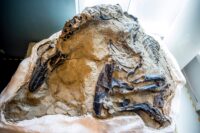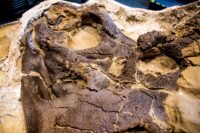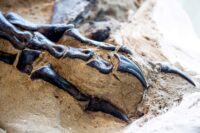 The Dueling Dinosaurs, two large dinosaurs locked in combat for 67 million years, have been gifted to the North Carolina Museum of Natural Sciences. It’s the ideal outcome for a saga that began 14 years ago and could very well have ended with the disappearance of this one-of-a-kind natural treasure into anonymous private hands.
The Dueling Dinosaurs, two large dinosaurs locked in combat for 67 million years, have been gifted to the North Carolina Museum of Natural Sciences. It’s the ideal outcome for a saga that began 14 years ago and could very well have ended with the disappearance of this one-of-a-kind natural treasure into anonymous private hands.
When they were put up for auction in 2013, they were believed to be the fossils of the carnivore Nanotyrannus lancensis and the herbivore Chasmosaurine ceratopsian, but the specimens have now been identified the carnivore as a juvenile Tyrannosaurus rex and the herbivore as a Triceratops horridus. In other words, this was the real-life version of the  most epic clash staged in toy rooms around the world. As if that weren’t cool enough, both the T. rex and the Triceratops are the most complete fossils of their species ever discovered. Tyrannosaurus is the only 100% complete T. rex fossil ever found. They went down in loose sandstone, died and were preserved locked in position.
most epic clash staged in toy rooms around the world. As if that weren’t cool enough, both the T. rex and the Triceratops are the most complete fossils of their species ever discovered. Tyrannosaurus is the only 100% complete T. rex fossil ever found. They went down in loose sandstone, died and were preserved locked in position.
The dinosaur carcasses have not been studied and remain entombed within sediment from the Montana hillside where they were discovered. Because of these rare burial conditions, each bone is in its natural position and Museum scientists will have access to biological data that is typically lost in the excavation and preparation processes. Entombing sediment preserves extraordinary features such as body outlines, skin impressions and other soft tissues, as well as injuries and potential evidence of interaction, such as tyrannosaur teeth embedded in the Triceratops body. This distinct preservation will provide Museum paleontologists with an unprecedented opportunity for research and education as they work to uncover the fossils and learn from them in the years to come.
The fossils were unearthed in Montana in 2006. The finders, a rancher, his cousin and a friend who hunt fossils for fun and profit, were given permission to search by the landowners Mary Anne and Lige Murray. The unique find made headlines and with the prospect of a multi-million dollar sale in the offing, trouble ensued. The Murrays had bought the land from brothers Jerry and Robert Severson in 2005. The brothers retained two-thirds of the mineral rights, however, and with the fossils going under the hammer in 2013, the Seversons claimed part ownership on the grounds that Montana law defined fossils as minerals.
The fossils failed to meet the reserve price of $6 million at the 2013 auction so there was no sale, but the lawsuit opened a huge can of worms. If fossils belong to whoever owns the mineral rights instead of surface rights, paleontologists would have to negotiate with landowners for access to the dig site, then separately with the mineral owners. Mineral rights change hands a lot so owners aren’t necessarily easy to determine, and corporate entities predominate. Even the Seversons’ interests are owned by LLCs. It would also cast down on legal title of fossils that are already in museum collections, potentially resulting in a cascade of new ownership claims and sell-offs.
 District court ruled for the Murrays first, but in 2018 a panel of the federal 9th U.S. Circuit Court of Appeals came down on the side of the mineral rights owners. The Murrays filed for a rehearing and the full circuit court referred the case to the Montana Supreme Court. In 2019, state legislature passed a law declaring that fossils belong to the surface estate, but the legislation was not retroactive and the Murray case still had to make its way through the legal system. In May of this year, the Montana Supreme Court ruled that fossils are not minerals but rather belong to the land in which they were discovered.
District court ruled for the Murrays first, but in 2018 a panel of the federal 9th U.S. Circuit Court of Appeals came down on the side of the mineral rights owners. The Murrays filed for a rehearing and the full circuit court referred the case to the Montana Supreme Court. In 2019, state legislature passed a law declaring that fossils belong to the surface estate, but the legislation was not retroactive and the Murray case still had to make its way through the legal system. In May of this year, the Montana Supreme Court ruled that fossils are not minerals but rather belong to the land in which they were discovered.
With the legalities sorted out, the nonprofit Friends of the North Carolina Museum of Natural Sciences was able to negotiate the acquisition. The museum is going all-out to showcase and study their new dinosaurs.
“The Museum is thrilled to have the unique opportunity to house and research one of the most important paleontological discoveries of our time,” said Dr. Eric Dorfman, director and CEO of the North Carolina Museum of Natural Sciences. “Not only are we able to uncover unknown details of these animals’ anatomy and behavior, but our new dedicated facility and educational programs will allow us to engage with audiences locally, across North Carolina, and worldwide.”
The renovation will be located on the ground floor of the innovative Nature Research Center and will include high-tech exhibit spaces, an area where visitors can explore the tools and techniques used by paleontologists, and an exemplary science laboratory dubbed the “SECU DinoLab,” where scientists will research the specimens live in front of the public. Museum guests will have a unique opportunity to enter the SECU DinoLab and talk directly to the paleontology team. This state-of-the-art facility will also feature video feeds and research updates so the public, both onsite and online, can follow along live as paleontologists work to reveal and share their Dueling Dinosaurs discoveries.
“We have not yet studied this specimen; it is a scientific frontier. The preservation is phenomenal, and we plan to use every technological innovation available to reveal new information on the biology of T. rex and Triceratops. This fossil will forever change our view of the world’s two favorite dinosaurs,” said Dr. Lindsay Zanno, head of paleontology at the North Carolina Museum of Natural Sciences and associate research professor at North Carolina State University. “The way we have designed the entire experience — inviting the public to follow the scientific discoveries in real time and participate in the research — will set a new standard for museums.”